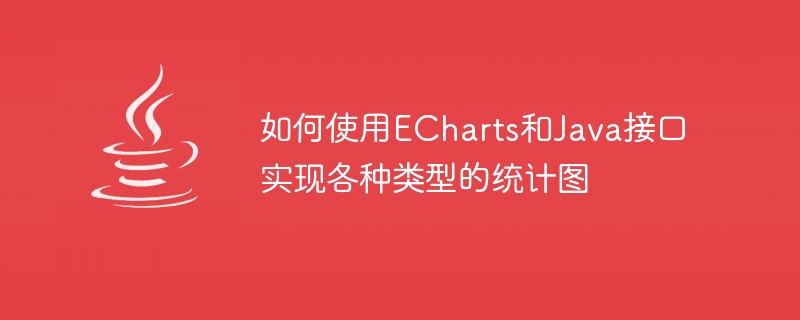

How to use ECharts and Java interfaces to implement various types of statistical charts
With the advent of the big data era, data analysis and visualization have become important tools and technologies . Statistical charts are one of the common forms of data visualization, which can visually display the distribution, trend, correlation and other information of data. ECharts is an open source chart library based on JavaScript, with powerful data visualization capabilities and rich chart types. As a programming language widely used in back-end development, Java also has many mature frameworks and libraries available for use. This article will introduce how to use ECharts and Java interfaces to implement various types of statistical charts, and provide specific code examples.
First, we need to prepare the required environment and tools. Before using ECharts and Java interfaces to implement statistical charts, we need to install the relevant dependencies of JDK and ECharts, and configure the project's construction environment. For specific installation and configuration steps, please refer to official documents and related tutorials.
Next, we can start writing code. Suppose we want to implement a simple histogram and display some simulated data. First, we can create a Java class namedBarChartDemo, and introduce related packages and classes:
import com.github.abel533.echarts.AxisPointer; import com.github.abel533.echarts.Grid; import com.github.abel533.echarts.Legend; import com.github.abel533.echarts.Option; import com.github.abel533.echarts.Tooltip; import com.github.abel533.echarts.axis.CategoryAxis; import com.github.abel533.echarts.axis.ValueAxis; import com.github.abel533.echarts.code.Trigger; import com.github.abel533.echarts.json.GsonOption; import com.github.abel533.echarts.series.Bar; import com.github.abel533.echarts.style.TextStyle;
Then, we can write a method to generate the data of the histogram and Configuration items. In this method, we can set the title, legend, axis, etc. of the chart, and add data to the chart. The specific code example is as follows:
public class BarChartDemo { public static String getBarChart() { // 创建Option对象,用于配置图表的全局属性 Option option = new GsonOption(); // 设置图表的标题 option.title().text("柱状图示例"); // 设置图表的图例 option.legend().data("销量"); // 创建X轴的类目轴,设置类目数据 CategoryAxis xAxis = new CategoryAxis(); xAxis.data("衬衫", "羊毛衫", "雪纺衫", "裤子", "高跟鞋", "袜子"); // 创建Y轴的值轴 ValueAxis yAxis = new ValueAxis(); // 创建柱状图系列 Bar bar = new Bar("销量"); bar.data(5, 20, 36, 10, 10, 20); // 将X轴、Y轴和柱状图系列添加到Option对象中 option.xAxis(xAxis); option.yAxis(yAxis); option.series(bar); // 将Option对象转换为JSON字符串 return option.toPrettyString(); } }
Next, we can call this method in the Java interface and return the generated histogram data. In this interface, we can use Spring MVC or other frameworks to implement API publishing and response. The specific code example is as follows:
@RestController @RequestMapping("/api") public class ChartController { @GetMapping("/barchart") public String getBarChart() { return BarChartDemo.getBarChart(); } }
Finally, we can access this Java interface through a browser or other tools and obtain the generated histogram data. Through the combination of ECharts and Java interfaces, we can realize various types of statistical charts, such as line charts, pie charts, radar charts, etc. Just write the corresponding code according to the specific needs and ECharts documentation.
In summary, this article introduces how to use ECharts and Java interfaces to implement various types of statistical charts, and provides specific code examples. Through learning and practice, I believe readers can master this technology and apply it to actual projects to display and analyze data visualization effects. I hope this article is helpful to readers, thank you for reading!
The above is the detailed content of How to use ECharts and Java interfaces to implement various types of statistical charts. For more information, please follow other related articles on the PHP Chinese website!
 What is ECharts
What is ECharts echarts adaptive size settings
echarts adaptive size settings How to switch between Huawei dual systems
How to switch between Huawei dual systems How to check for plagiarism on CNKI Detailed steps for checking for plagiarism on CNKI
How to check for plagiarism on CNKI Detailed steps for checking for plagiarism on CNKI What does xml format mean
What does xml format mean math.random function usage
math.random function usage The difference between * and & in C language
The difference between * and & in C language What to do if you can't delete files on your computer
What to do if you can't delete files on your computer



